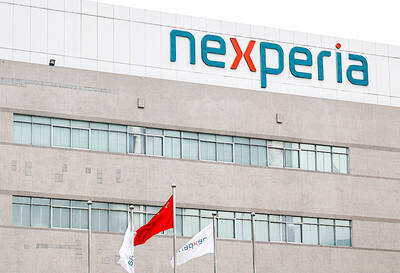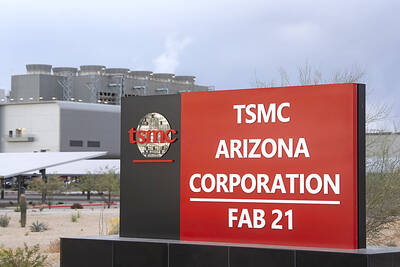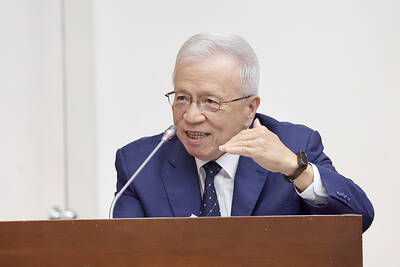US authorities have reached out to several financial institutions asking them to make bids on the assets of troubled First Republic Bank, a source familiar with the matter said.
First Republic has been under heavy pressure after the bankruptcies in early March of fellow regional banks Silicon Valley Bank (SVB) and Signature Bank sparked fears of contagion.
However, First Republic has failed to come up with a workable rescue plan and on Monday last week it disclosed that it had lost more than US$100 billion in deposits in the first quarter, causing its shares to plummet.

Photo: Bloomberg
The federal government finally stepped in with the Federal Deposit Insurance Corp (FDIC), an agency in charge of guaranteeing bank deposits, and the US Department of the Treasury approaching six banks last week to gauge their interest in buying First Republic assets, according to the source, who spoke on condition of anonymity.
The person said four of those six were likely to submit bids.
Several US news outlets reported that the FDIC would initially take control of First Republic as part of the rescue plan. The agency would then quickly sell some or all of the bank’s assets to another institution.
If the deal goes through, it could be announced early today to placate First Republic customers, CNBC reported.
With its assets standing at US$233 billion at the end of March, First Republic would be the second-largest bank to fall in US history — excluding investment banks such as Lehman Brothers Holdings Inc — after Washington Mutual Inc’s bankruptcy in 2008.
Meanwhile, the US Federal Reserve called for greater banking oversight while admitting to its own failures in a widely anticipated report published on Friday into the collapse of SVB.
“Following Silicon Valley Bank’s failure, we must strengthen the Federal Reserve’s supervision and regulation based on what we have learned,” Fed Vice Chair for Supervision Michael Barr wrote in a statement accompanying the report.
SVB’s management failed to adequately manage risk prior to the bank’s swift collapse, while Fed supervisors “failed to take forceful enough action” after identifying issues at the California-based high-tech lender, he said.
Barr’s report said that the Fed “did not appreciate the seriousness of critical deficiencies in the firm’s governance, liquidity, and interest rate risk management,” as SVB’s assets more than doubled in size from 2019 to 2021 in the middle of a high-tech boom.
Barr said the Fed would look at strengthening banking supervision to ensure it can more quickly identify risks and vulnerabilities such as those that arose at SVB.
The Fed would also strengthen the regulatory framework for banks, and consider toughening the rules around interest rate risk, liquidity and capital requirements, and stress testing.

JITTERS: Nexperia has a 20 percent market share for chips powering simpler features such as window controls, and changing supply chains could take years European carmakers are looking into ways to scratch components made with parts from China, spooked by deepening geopolitical spats playing out through chipmaker Nexperia BV and Beijing’s export controls on rare earths. To protect operations from trade ructions, several automakers are pushing major suppliers to find permanent alternatives to Chinese semiconductors, people familiar with the matter said. The industry is considering broader changes to its supply chain to adapt to shifting geopolitics, Europe’s main suppliers lobby CLEPA head Matthias Zink said. “We had some indications already — questions like: ‘How can you supply me without this dependency on China?’” Zink, who also

At least US$50 million for the freedom of an Emirati sheikh: That is the king’s ransom paid two weeks ago to militants linked to al-Qaeda who are pushing to topple the Malian government and impose Islamic law. Alongside a crippling fuel blockade, the Group for the Support of Islam and Muslims (JNIM) has made kidnapping wealthy foreigners for a ransom a pillar of its strategy of “economic jihad.” Its goal: Oust the junta, which has struggled to contain Mali’s decade-long insurgency since taking power following back-to-back coups in 2020 and 2021, by scaring away investors and paralyzing the west African country’s economy.

Taiwan Semiconductor Manufacturing Co (TSMC, 台積電) received about NT$147 billion (US$4.71 billion) in subsidies from the US, Japanese, German and Chinese governments over the past two years for its global expansion. Financial data compiled by the world’s largest contract chipmaker showed the company secured NT$4.77 billion in subsidies from the governments in the third quarter, bringing the total for the first three quarters of the year to about NT$71.9 billion. Along with the NT$75.16 billion in financial aid TSMC received last year, the chipmaker obtained NT$147 billion in subsidies in almost two years, the data showed. The subsidies received by its subsidiaries —

BUST FEARS: While a KMT legislator asked if an AI bubble could affect Taiwan, the DGBAS minister said the sector appears on track to continue growing The local property market has cooled down moderately following a series of credit control measures designed to contain speculation, the central bank said yesterday, while remaining tight-lipped about potential rule relaxations. Lawmakers in a meeting of the legislature’s Finance Committee voiced concerns to central bank officials that the credit control measures have adversely affected the government’s tax income and small and medium-sized property developers, with limited positive effects. Housing prices have been climbing since 2016, even when the central bank imposed its first set of control measures in 2020, Chinese Nationalist Party (KMT) Legislator Lo Ting-wei (羅廷瑋) said. “Since the second half of